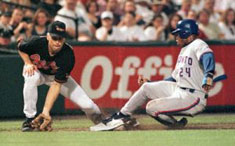
Running, continued: Why Run? How do you get a runner out?
 |
| Should I run? Will I be safe or out? |
Preliminary 1: The batter usually starts the action
The batter has to stay at home plate until he hits a fair ball, or is awarded a base, or acquires three strikes. In the latter case, he has made an out. In the other two cases, he must proceed toward first base.
Preliminary 2: At Risk or not at risk
Sometimes a batter or runner is awarded the right to advance to a base without the danger of making an out. He is said to be not at risk--until this brief action stops. You can usually spot these situations because the player walks or trots to a base--there is no need to run. The batter-runner is not at risk when he gets a walk, is hit by a pitch, or hits a fair ball that leaves the park on the fly or on the bounce.
Most of the time, however, a runner or batter-runner is at risk of making an out. In this case, he is in danger until he touches, and stays on, a base that he has a right to occupy.
 |
| The baseball hasn't arrived to the defensive player. The runner is safe. |
Preliminary 3: Forced to move or not forced
Given that two offensive players can't occupy the same base at the same time, when the batter-runner--at risk or not at risk--is forced to advance to first base or beyond, he forces one or more runners in front of him to abandon their respective bases.
The only runners forced to move are those who are occupying a base that someone behind them has to occupy. There may be one or two runners who are not forced to do anything when a batter-runner is forced to go to a base, simply because no other runner is being forced to occupy those runners' bases. For example, consider that Runner F is on first base, and Runner T is on third base. If Batter H hits a fair-ball on the ground, H has to try to gain first base and F has to abandon it. But T does not have to leave third base, because no other runner "needs" it. Most anytime he wishes, T is free to leave his base&mdash. He may think it's a good time to try to score a run in this situation—but he is at risk of making an out.
Conclusion: Runners sometimes stroll and sometimes sprint
When the batter-runner is not at risk of making an out, any runners that he forces to move are also not at risk. For example, when the batter receives a walk or is hit by a pitch, any runner who has been occupying first base is "pushed" to second. If there were also a runner there, he would have to move to third base. If someone were already on third, he would have to take a pleasant stroll to home plate and score a run. Everyone takes his time because no one is at risk of making an out during this action. Similarly, if the batter hit a home run over the wall, all runners are calmly pushed to home plate, each scoring a run in the process.
When the batter-runner is at risk, any runners he forces to move are also at risk of making an out. So they should run to the next base as fast as possible.
How to Put (or "Get", or "Make") a Runner Out
 |
| A defensive player can block any base as long as he has the baseball or is trying to catch it. Here, a catcher is blocking home plate, trying to tag a runner before he touches it and scores a run. |
The general conditions under which the defense can get a runner or batter-runner out are:
- He is at risk, i.e. he is not in the act of reaching a base that he has been freely awarded—because the batter got a walk, was hit by a pitch, etc.
- He is not touching a base to which he has a right.
Tag-out. In the above circumstances, the defense can always get a runner or batter-runner out by tagging him with the ball. That is, a defensive player can touch him with the hand (or glove) that is holding the baseball. The players in question don't have to be anywhere in particular on the playing field.
Force-out. This only works on a runner or batter-runner who is forced to run to a base. Again, he has to be at risk and not touching a rightful base. If he is forced to run to a certain base, a defensive player in possession of the baseball can simply make contact with that base with any part of his body, usually his foot. This is easier and faster than the other way of getting someone out, i.e. tagging him with the baseball—which also works in this situation.
An at-risk batter-runner is forced by the rules to try to reach first base. The force-out at first is perhaps the most common play in baseball.
If a runner leaves his base before a fly-ball is caught, the defense can either force him out at the base he left, or tag him out anywhere else on the field.



